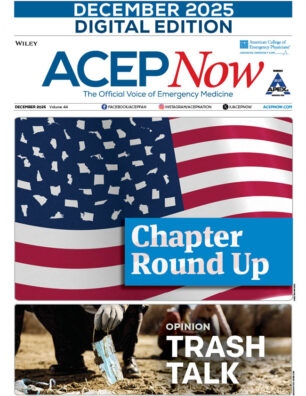
The Case
A 14-year-old male presents with a retained foreign body in his rectum. He states a glass bottle broke during sex with his boyfriend, who is 16 years old. He reports pain and bleeding. Chart review reveals a history of intravenous drug use, bipolar disorder, and history of child welfare involvement. He has had prior ED visits for psychiatric care, sexually transmitted infections, and an opioid overdose. On exam, he has moderate lower abdominal tenderness and bright red blood per rectum. His vital signs are stable. The foreign bodies are unable to be visualized. He repeatedly asks for pain medication.
Explore This Issue
ACEP Now: Vol 40 – No 01 – January 2021Case Resolution
Initial hematocrit is at the patient’s baseline. The surgical service is consulted. Staff members are noted to be joking about his condition. After treating the patient’s pain, you update him on the clinical plan. Sitting at eye level, you say, “Some of my patients have sex with people they would rather not have sex with. Sometimes they do that to pay for things they need to get by. If someone is hurting you, I’d need to tell someone. That also may get you help that I wouldn’t be able to connect you with otherwise.” The patient then discloses that he was with a “date” this evening and things turned violent. Since running away from his foster home two years ago, he does what he has to in order to survive, including commercial sex. You thank him for sharing this. The patient is taken to the operating room. You make a report to child welfare.
The Definition
According to U.S. law, any individual under the age of 18 who has engaged in commercial sex is considered to be trafficked. While the word “trafficking” connotes movement, someone may be trafficked in their own home, without crossing town, state, or country borders. While prevalence estimates are limited, given the clandestine nature of the issue, what is known is that those with an experience of trafficking come into contact with emergency clinicians, and few emergency clinicians are equipped to respond.1–3
Red Flags
The goal of an encounter with a potentially trafficked person is not disclosure or rescue. It is educating and empowering them with resources. The recognition of exploited children may prove challenging. The trafficked child may be accompanied by someone posing as a family member, significant other, or friend but who is in fact a trafficker or another trafficking victim. In many cases, the trafficker may actually be a relative of the patient.4
There may be clues in the patient’s presentation suggesting they may be vulnerable to trafficking. Patients may present to the emergency department for a number of issues, including retained foreign bodies, sexually transmitted infections, substance use or overdose, psychiatric issues, chronic pain, pregnancy, or abortion complications. The adult accompanying the patient may be unwilling to leave the patient alone with emergency department staff.
Children who are in the child welfare system; runaways; children who identify as LGBTQ; those with a history of substance use; and those with a history of physical abuse, sexual abuse, or neglect are at high risk to become victims of sexual exploitation.5
Inquiring about a trafficking experience should be done thoughtfully and is not as simple as going through a checklist of questions. One approach, the Privacy, Education, Ask, Respect, Respond (PEARR) tool, adapted from the field of domestic violence, shows promise for assessing a patient for trafficking and was used in this patient scenario. It is important to speak with the patient alone and to use a trained interpreter if necessary. Questions should be direct and nonjudgmental. Of note, screening tools for child sex trafficking are currently in the process of validation.6,7
There are several potential barriers to disclosure. First, clinicians may unconsciously or consciously judge a patient, which obscures the ability to see their patient’s exploitation.8 Lack of awareness of trafficking and its diversity of presentations can prevent a clinician from identifying a trafficked person. On the patient side, males in particular may not recognize the exploitation of their situation or resonate with the word “victim.” Shame and stigma may also block disclosure. A patient may sense a judgmental attitude, as in the case described, and be less open as a result.9 Furthermore, if a patient’s presence in the United States is unauthorized, they may be afraid to tell their doctor for fear of deportation.10
Treat and Report
As with any emergency department patient, the priority is to identify and treat all life-, limb-, and organ-threatening issues. The history and physical examination will direct the laboratory and radiographic workup needed. If requested or consented to by the patient, sexual assault evidence collection should be performed early in the emergency department visit. Patients should be tested for sexually transmitted infections and pregnancy, as applicable. Placement for drug and/or alcohol rehabilitation should be considered if indicated.
According to the revised federal Child Abuse Prevention and Treatment Act, the sexual exploitation of minors is child abuse, and health care professionals are mandated reporters of child abuse. As such, calls should be made to the relevant authorities. As was done in this case, a discussion of the limits of confidentiality should be completed prior to asking questions that may elicit a disclosure.11
Departments should develop specific evidence-based policies regarding the evaluation, care, and management of suspected trafficking victims.12 In addition, other resources should be engaged, including local legal aid, social work, victim advocates, and, when appropriate, law enforcement. The National Human Trafficking Hotline (888-373-7888) is available 24 hours a day and can help with assessment, access to shelter, and safety planning. For non-U.S. residents, the Office of Refugee Resettlement of the U.S. Department of Justice can provide refugee status to victims of trafficking.13
Edited by Hanni Stoklosa, MD, MPH, an emergency physician at Brigham and Women’s Hospital in Boston and executive director and co-founder of HEAL Trafficking.
References
- Baldwin SB, Eisenman DP, Sayles JN, et al. Identification of human trafficking victims in health care settings. Health Hum Rights. 2011;13(1):E36-49.
- Lederer L, Wetzel C. The health consequences of sex trafficking and their implications for identifying victims in healthcare facilities. Ann Health Law. 2014:23(1):61-91.
- Chisolm-Straker M, Baldwin S, Gaïgbé-Togbé B, et al. Health care and human trafficking: we are seeing the unseen. J Health Care Poor Underserved. 2016;27(3):1220-1233.
- IOM launches updated counter trafficking data portal with new statistics. International Organization for Migration website. Accessed Dec. 24, 2020.
- Chaffee T, English A. Sex trafficking of adolescents and young adults in the United States. Curr Opin Obstet Gynecol. 2015;27(5):339-344.
- Chisolm‐Straker M, Singer E, Rothman EF, et al. Building RAFT: trafficking screening tool derivation and validation methods. Acad Emerg Med. 2020;27(4):297-304.
- Armstrong S. Instruments to identify commercially sexually exploited children: feasibility of use in an emergency department setting. Pediatr Emerg Care. 2017;33(12):794-799.
- Stoklosa H, MacGibbon M, Stoklosa J. Human trafficking, mental illness, and addiction: avoiding diagnostic overshadowing. AMA J Ethics. 2017;19(1):23-34.
- Miller CL, Chisolm-Straker M, Duke G, et al. A framework for the development of healthcare provider education programs on human trafficking part three: recommendations. J Human Trafficking. 2020;6(4):425-434.
- Restore NYC. Healthcare access for foreign-national survivors of trafficking. Accessed Dec. 24, 2020.
- English A. Mandatory reporting of human trafficking: potential benefits and risks of harm. AMA J Ethics. 2017;19(1):54-62.
- HEAL Trafficking and Hope for Justice’s protocol toolkit. HEAL Trafficking website. Accessed Dec. 24, 2020.
- Becker HJ, Bechtel K. Recognizing victims of human trafficking in the pediatric emergency department. Pediatr Emerg Care. 2015;31(2):144-147; quiz 148-150.
Pages: 1 2 3 | Multi-Page





No Responses to “Tips for Recognizing, Treating, and Reporting Child Sex Trafficking in the Emergency Department”